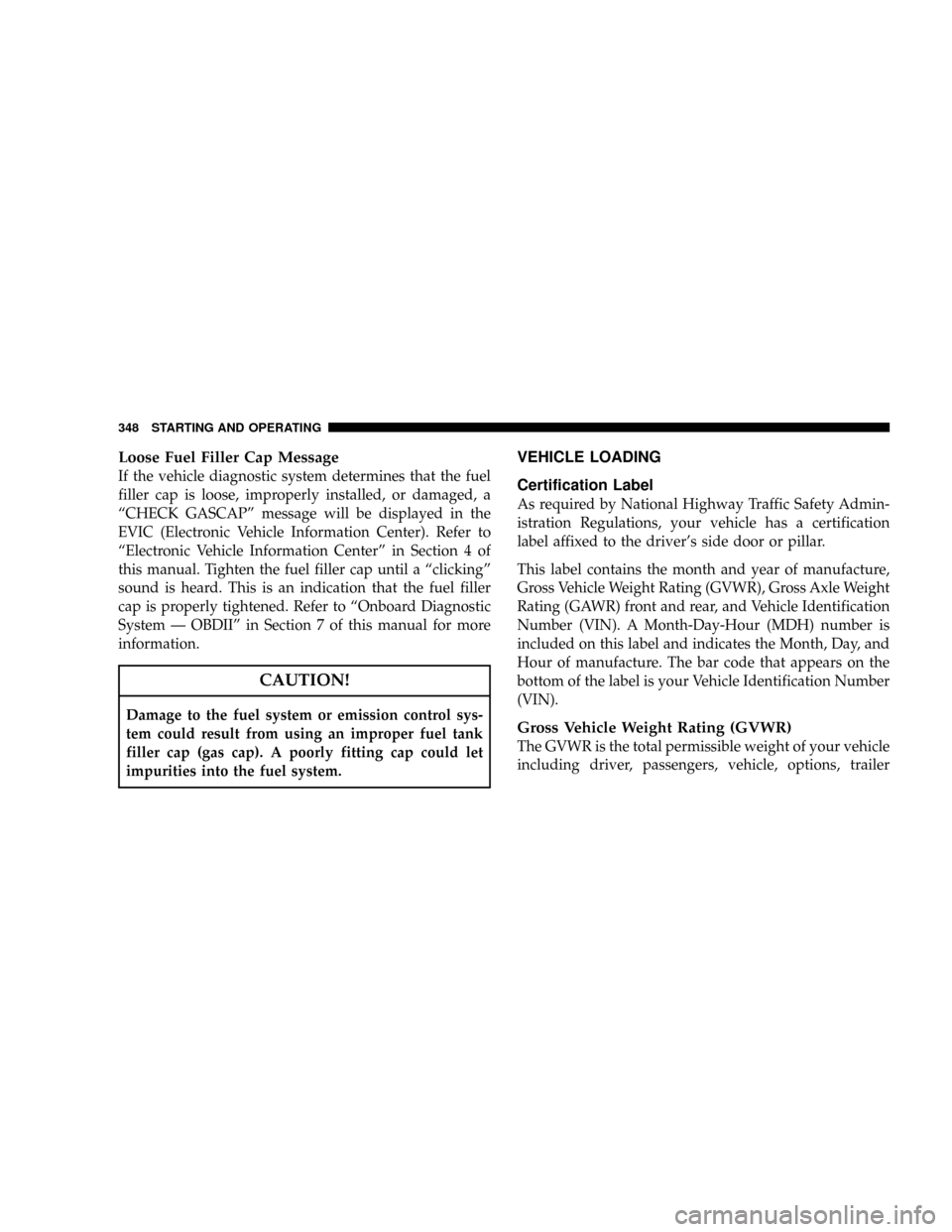Page 345 of 490
WARNING!
Do not use alcohol or gasoline as a fuel blending
agent. They can be unstable under certain conditions
and hazardous or explosive when mixed with diesel
fuel.Diesel fuel is seldom completely free of water. To prevent
fuel system trouble, drain the accumulated water from
the fuel/water separator using the fuel/water separator
drain provided. If you buy good quality fuel and follow
the cold weather advice above, fuel conditioners should
not be required in your vehicle. If available in your area,
a high cetane ªpremiumº diesel fuel may offer improved
cold-starting and warm-up performance.
ADDING FUEL
CAUTION!
DO NOT put gasoline in your diesel vehicle (if
equipped). If you accidentally put gasoline in your
vehicle, DO NOT start the engine. This will cause
damage to the fuel system. Have the fuel system
flushed.
Ultra-Low Sulfur Diesel Fuel Label
STARTING AND OPERATING 345
5
Page 346 of 490
Fuel Filler Cap (Gas Cap)
The gas cap is located behind the fuel filler door, on the
driver's side of the vehicle. If the gas cap is lost or
damaged, be sure the replacement cap is for use with this
vehicle.CAUTION!
Damage to the fuel system or emission control sys-
tem could result from using an improper fuel cap
(gas cap). A poorly fitting cap could let impurities
into the fuel system. Also, a poorly fitting after-
market cap can cause the MIL (Malfunction Indicator
Light) to illuminate, due to fuel vapors escaping from
the system.
CAUTION!
A poorly fitting gas cap may cause the Malfunction
Indicator Light to turn on.
Fuel Filler Cap Location
346 STARTING AND OPERATING
Page 347 of 490
CAUTION!
To avoid fuel spillage and overfilling, do not ªtop
offº the fuel tank after filling.
NOTE:When the fuel nozzle ªclicksº or shuts off, the
fuel tank is full.
WARNING!
²Never have any smoking materials lit in or near
the vehicle when the gas cap is removed or the
tank filled.
²Never add fuel when the engine is running. This is
in violation of most state and federal fire regula-
tions and will cause the malfunction indicator
light to turn on.NOTE:Tighten the gas cap about 1/4 turn until you
hear one click. This is an indication that cap is properly
tightened.
If the gas cap is not tighten properly, the Malfunction
Indicator Light will come on. Be sure the gas cap is
tightened every time the vehicle is refueled.
WARNING!
A fire may result if gasoline is pumped into a
portable container that is inside of a vehicle. You
could be burned. Always place gas containers on the
ground while filling.
STARTING AND OPERATING 347
5
Page 348 of 490

Loose Fuel Filler Cap Message
If the vehicle diagnostic system determines that the fuel
filler cap is loose, improperly installed, or damaged, a
ªCHECK GASCAPº message will be displayed in the
EVIC (Electronic Vehicle Information Center). Refer to
ªElectronic Vehicle Information Centerº in Section 4 of
this manual. Tighten the fuel filler cap until a ªclickingº
sound is heard. This is an indication that the fuel filler
cap is properly tightened. Refer to ªOnboard Diagnostic
System Ð OBDIIº in Section 7 of this manual for more
information.
CAUTION!
Damage to the fuel system or emission control sys-
tem could result from using an improper fuel tank
filler cap (gas cap). A poorly fitting cap could let
impurities into the fuel system.
VEHICLE LOADING
Certification Label
As required by National Highway Traffic Safety Admin-
istration Regulations, your vehicle has a certification
label affixed to the driver's side door or pillar.
This label contains the month and year of manufacture,
Gross Vehicle Weight Rating (GVWR), Gross Axle Weight
Rating (GAWR) front and rear, and Vehicle Identification
Number (VIN). A Month-Day-Hour (MDH) number is
included on this label and indicates the Month, Day, and
Hour of manufacture. The bar code that appears on the
bottom of the label is your Vehicle Identification Number
(VIN).
Gross Vehicle Weight Rating (GVWR)
The GVWR is the total permissible weight of your vehicle
including driver, passengers, vehicle, options, trailer
348 STARTING AND OPERATING
Page 349 of 490

tongue weight, and cargo. The label also specifies maxi-
mum capacities of front and rear axle systems (GAWR).
Total load must be limited, so GVWR, and front and rear
GAWR are not exceeded.
Payload
The payload of a vehicle is defined as the allowable load
weight a truck can carry, including the weight of the
driver, all passengers, options and cargo.
Gross Axle Weight Rating (GAWR)
The GAWR is the maximum permissible load on the front
and rear axles. The load must be distributed in the cargo
area so that the GAWR of each axle is not exceeded.
Each axle GAWR is determined by the components in the
system with the lowest load carrying capacity (axle,
springs, tires, or wheels). Heavier axles or suspension
components sometimes specified by purchasers for in-
creased durability does not necessarily increase the vehi-
cle's GVWR.
Tire Size
The tire size on the Label represents the actual tire size on
your vehicle. Replacement tires must be equal to the load
capacity of this tire size.
Rim Size
This is the rim size that is appropriate for the tire size
listed.
Inflation Pressure
This is the cold tire inflation pressure for your vehicle for
all loading conditions up to full GAWR.
Curb Weight
The curb weight of a vehicle is defined as the total weight
of the vehicle with all fluids, including vehicle fuel, at full
capacity conditions, and with no occupants or cargo
loaded into the vehicle. The front and rear curb weight
values are determined by weighing your vehicle on a
commercial scale before any occupants or cargo are
added.
STARTING AND OPERATING 349
5
Page 363 of 490

Towing Tips Ð Automatic Transmission
The ªDº range can be selected when towing. However, if
frequent shifting occurs while in this range, the ºTow/
Haulº mode (if equipped) or a lower gear range should
be selected.
NOTE:Using the ºTow/Haulº mode (if equipped) or a
lower gear range while operating the vehicle under
heavy operating conditions will improve performance
and extend transmission life by reducing excessive shift-
ing and heat build up. This action will also provide better
engine braking.
The automatic transmission fluid and filter should be
changed if you REGULARLY tow a trailer for more than
45 minutes of continuous operation. Refer to the ªMain-
tenance Scheduleº in Section 8 of this manual for trans-
mission fluid change intervals.
NOTE:Check the automatic transmission fluid level
before towing.
Towing Tips Ð Electronic Speed Control (If
Equipped)
þ
Don't use in hilly terrain or with heavy loads.
þWhen using the speed control, if you experience speed
drops greater than 10 mph (16 km/h), disengage until
you can get back to cruising speed.
þUse speed control in flat terrain and with light loads to
maximize fuel efficiency.
Towing Tips Ð Cooling System
To reduce potential for engine and transmission over-
heating, take the following actions:
þCity Driving
When stopped for short periods of time, put transmission
in N (Neutral) and increase engine idle speed.
þHighway Driving
Reduce speed.
STARTING AND OPERATING 363
5
Page 383 of 490
MAINTAINING YOUR VEHICLE
CONTENTS
mEngine Compartment ± 3.7L...............386
mEngine Compartment ± 4.7L...............387
mEngine Compartment ± 5.7L...............388
mEngine Compartment ± 3.0L Diesel..........389
mOnboard Diagnostic System Ð OBD II........390
NLoose Fuel Filler Cap Message............391
mEmissions Inspection And Maintenance
Programs............................391
mReplacement Parts......................393mDealer Service.........................393
mMaintenance Procedures..................394
NEngine Oil..........................394
NDrive Belts Ð Check Condition And Tension . . 398
NSpark Plugs.........................398
NSpark Plug Wires.....................398
NEngine Air Cleaner Filter................398
NCatalytic Converter....................399
NCrankcase Emission Control System........400
7
Page 384 of 490

NMaintenance-Free Battery................401
NAir Conditioner Maintenance.............402
NPower Steering Fluid Check..............403
NBody Lubrication.....................405
NWindshield Wiper Blades................405
NWindshield Washers Ð Front And Rear.....405
NExhaust System......................406
NCooling System.......................407
NHoses And Vacuum/Vapor Harnesses.......412
NFuel System Connections................412
NBrake System........................413
NFront/Rear Axle Fluid..................415
NTransfer Case........................416NAutomatic Transmission................417
NMaintenance After Off-Road Driving........420
NAppearance Care And Protection From
Corrosion...........................421
mFuse Panel...........................426
NInterior Fuses........................426
NUnderhood Fuses (Power Distribution
Center)............................429
NUnderhood Fuses (Integrated Power
Module)............................432
mVehicle Storage........................433
mReplacement Bulbs......................434
mBulb Replacement......................435
384 MAINTAINING YOUR VEHICLE